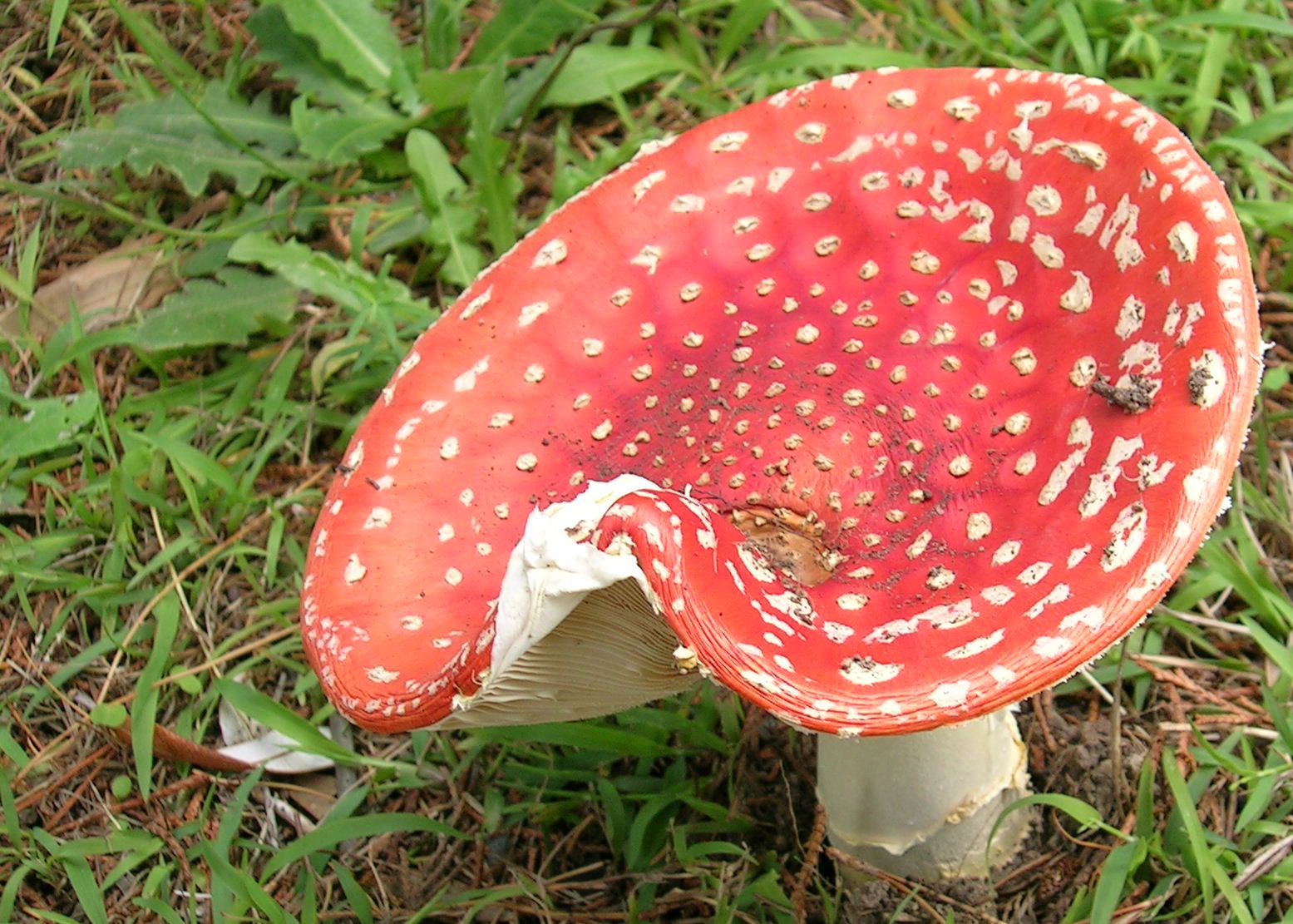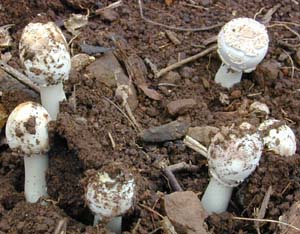|
Inocybe Pudica
''Inocybe whitei'', also known as ''Inocybe pudica'' and commonly known as the blushing inocybe, is a species of agaric fungus in the family Cortinariaceae. Taxonomy The species was originally defined as ''Agaricus whitei'' by Miles Joseph Berkeley and Christopher Edmund Broome in 1876 and transferred to the genus ''Inocybe'' by Pier Andrea Saccardo in 1887. The species was also described independently as ''Inocybe pudica'' by Robert Kühner in 1947. Nowadays the two names are considered synonyms, with Berkeley and Broome's name taking precedence. The epithet ''whitei'' was given in honour of Dr. Buchanan White, a naturalist of Perthshire. Description The mushroom is initially white then develops reddish stains. The cap is wide and conical, then convex to flat with an umbo. The gills vary in attachment and are pallid at first, but darken with maturity. The spore print is brown. The stalk is 4–8 cm long and 0.5–1 cm thick. The flesh has an unpleasant or spermatic ... [...More Info...] [...Related Items...] OR: [Wikipedia] [Google] [Baidu] |
Berk
Berk may refer to: * Berk (name), a surname, given name, or any of several people with that name * Berk, Bolu, Turkey, a village * Berk Trade and Business School, New York City * Berk, a fictional island in the ''How to Train Your Dragon'' series of books and films * , a torpedo cruiser of the Ottoman Navy later renamed ''Berk'' * Berk, rhyming slang often used to mean "foolish person" * ''Berk.'', taxonomic author abbreviation of Miles Joseph Berkeley (1803–1889), English cryptogamist and founder of the science of plant pathology See also * * Berk–Tabatznik syndrome, a medical condition * De Berk (other) * Berks (other) * Birk (other) * Berkshire (other) * Berkeley (other) Berkeley most often refers to: *Berkeley, California, a city in the United States **University of California, Berkeley, a public university in Berkeley, California *George Berkeley (1685–1753), Anglo-Irish philosopher Berkeley may also refer to .. ... [...More Info...] [...Related Items...] OR: [Wikipedia] [Google] [Baidu] |
Spore Print
300px, Making a spore print of the mushroom ''Volvariella volvacea'' shown in composite: (photo lower half) mushroom cap laid on white and dark paper; (photo upper half) cap removed after 24 hours showing warm orange ("tussock") color spore print. A 3.5-centimeter glass slide placed in middle allows for examination of spore characteristics under a microscope. The spore print is the powdery deposit obtained by allowing spores of a fungal fruit body to fall onto a surface underneath. It is an important diagnostic character in most handbooks for identifying mushrooms. It shows the colour of the mushroom spores if viewed en masse. Method A spore print is made by placing the spore-producing surface flat on a sheet of dark and white paper or on a sheet of clear, stiff plastic, which facilitates moving the spore print to a darker or lighter surface for improved contrast; for example, it is easier to determine whether the spore print is pure white or, rather, very slightly pigmented. ... [...More Info...] [...Related Items...] OR: [Wikipedia] [Google] [Baidu] |
Fungi Of North America
A fungus (: fungi , , , or ; or funguses) is any member of the group of eukaryotic organisms that includes microorganisms such as yeasts and molds, as well as the more familiar mushrooms. These organisms are classified as one of the traditional eukaryotic kingdoms, along with Animalia, Plantae, and either Protista or Protozoa and Chromista. A characteristic that places fungi in a different kingdom from plants, bacteria, and some protists is chitin in their cell walls. Fungi, like animals, are heterotrophs; they acquire their food by absorbing dissolved molecules, typically by secreting digestive enzymes into their environment. Fungi do not photosynthesize. Growth is their means of mobility, except for spores (a few of which are flagellated), which may travel through the air or water. Fungi are the principal decomposers in ecological systems. These and other differences place fungi in a single group of related organisms, named the ''Eumycota'' (''true fungi'' or ''Eum ... [...More Info...] [...Related Items...] OR: [Wikipedia] [Google] [Baidu] |
MycoBank
MycoBank is an online database, documenting new mycological names and combinations, eventually combined with descriptions and illustrations. It is run by the Westerdijk Fungal Biodiversity Institute in Utrecht. Each novelty, after being screened by nomenclatural experts and found in accordance with the ICN (International Code of Nomenclature for algae, fungi, and plants), is allocated a unique MycoBank number before the new name has been validly published. This number then can be cited by the naming author in the publication where the new name is being introduced. Only then, this unique number becomes public in the database. By doing so, this system can help solve the problem of knowing which names have been validly published and in which year. MycoBank is linked to other important mycological databases such as Index Fungorum, Life Science Identifiers, Global Biodiversity Information Facility (GBIF) and other databases. MycoBank is one of three nomenclatural repositories reco ... [...More Info...] [...Related Items...] OR: [Wikipedia] [Google] [Baidu] |
List Of Inocybe Species
''Inocybe'' is a large genus of mushroom-producing fungi in the order Agaricales. The genus is widely distributed in the Northern Hemisphere. , Index Fungorum accepts 848 species in ''Inocybe''. As of 2023, it is estimated that there are 1050 species in this genus. #A, A #B, B #C, C #D, D #E, E #F, F #G, G #H, H #I, I #J, J #K, K #L, L #M, M #N, N #O, O #P, P #Q, Q #R, R #S, S #T, T #U, U #V, V #U, U #W, W #X, X #Y, Y #Z, Z __NOTOC__ A *''Inocybe aberrans'' (E.Horak) Garrido 1988 *''Inocybe abietis'' Kühner 1953 *''Inocybe abnormispora'' Alessio 1987 *''Inocybe abundans'' Murrill 1911 *''Inocybe acriolen'' Grund & D.E.Stuntz 1975 *''Inocybe acuta'' Boud. 1917 *''Inocybe acutata'' Tak. Kobay. & Nagas. 1993 *''Inocybe acutoides'' Kokkonen & Vauras 2013 *''Inocybe acystidiosa'' Kauffman 1924 *''Inocybe adaequata'' (Britzelm.) Sacc. 1887 – Europe *'' Inocybe aeruginascens'' Babos 1970 (psychoactive) *''Inocybe aestiva'' Kropp, Matheny & Hutchison 2013 – USA *''Inocybe agard ... [...More Info...] [...Related Items...] OR: [Wikipedia] [Google] [Baidu] |
Muscarine
Muscarine, L-(+)-muscarine, or muscarin is a Secondary metabolite, natural product found in certain mushrooms, particularly in ''Inocybe'' and ''Clitocybe'' species, such as the deadly ''Clitocybe dealbata, C. dealbata''. Mushrooms in the genera ''Entoloma'' and ''Mycena'' have also been found to contain levels of muscarine which can be dangerous if ingested. Muscarine has been found in harmless trace amounts in the genera ''Boletus'', ''Hygrocybe'', ''Lactarius (fungus), Lactarius'' and ''Russula''. Trace concentrations of muscarine are also found in ''Amanita muscaria'', though the pharmacologically more relevant compound from this mushroom is the Z-drug-like alkaloid muscimol. ''A. muscaria'' basidiocarp, fruitbodies contain a variable dose of muscarine, usually around 0.0003% fresh weight. This is very low and toxicity symptoms occur very rarely. ''Inocybe'' and ''Clitocybe'' contain muscarine concentrations up to 1.6%. Muscarine is a selective agonist of the muscar ... [...More Info...] [...Related Items...] OR: [Wikipedia] [Google] [Baidu] |
Mushroom Poisoning
Mushroom poisoning is poisoning resulting from the ingestion of mushrooms that contain toxicity, toxic substances. Signs and symptoms, Symptoms can vary from slight Gastrointestinal tract, gastrointestinal discomfort to death in about 10 days. Mushroom toxins are secondary metabolites produced by the fungus. Mushroom poisoning is usually the result of ingestion of wild mushrooms after misidentification of a Mycotoxin, toxic mushroom as an edible species. The most common reason for this misidentification is a close resemblance in terms of color and general Morphology (biology), morphology of the toxic mushrooms species with edible species. To prevent mushroom poisoning, mushroom gatherers familiarize themselves with the mushrooms they intend to collect, as well as with any similar-looking toxic species. The safety of eating wild mushrooms may depend on methods of preparation for cooking. Some toxins, such as amatoxins, are Thermostability, thermostable and mushrooms containing such ... [...More Info...] [...Related Items...] OR: [Wikipedia] [Google] [Baidu] |
Hygrophorus Russula
''Hygrophorus'' is a genus of agarics (gilled mushrooms) in the family Hygrophoraceae. Called "woodwaxes" in the UK or "waxy caps" (together with ''Hygrocybe'' species) in North America, basidiocarps (fruit bodies) are typically fleshy, often with slimy caps and lamellae that are broadly attached to decurrent. All species are ground-dwelling and ectomycorrhizal (forming an association with living trees) and are typically found in woodland. Around 100 species are recognized worldwide. Fruit bodies of several species are considered edible and are sometimes offered for sale in local markets. Taxonomy History ''Hygrophorus'' was first published in 1836 by Swedish mycologist Elias Magnus Fries. The generic name is derived from the Greek ῦγρὁς (= moist) + φόρος (= bearer), with reference to the slimy caps found in many species. Fries (1849) subsequently split the genus into three subgenera: ''Limacium'', ''Camarophyllus'', and ''Hygrocybe''. The last of these is now recogn ... [...More Info...] [...Related Items...] OR: [Wikipedia] [Google] [Baidu] |
Inocybe Fraudans
''Inocybe fraudans'', commonly known as the pear fibrecap, is an agaric fungus in the family Inocybaceae. It has a yellowish-brown fibrillose cap and stipe that develops reddish tints with age. The flesh has a characteristic odor, similar to jasmin or ripe pears, although the mushroom—like many in the genus ''Inocybe''—is suspected to be toxic. It is found in Europe and North America, where it grows in woodlands. Fruitbodies produce an walnut-brown spore print, and have smooth, almond-shaped spores measuring 8–11.5 by 5–7 μm The micrometre (Commonwealth English as used by the International Bureau of Weights and Measures; SI symbol: μm) or micrometer (American English), also commonly known by the non-SI term micron, is a unit of length in the International System .... Many authors have erroneously referred this species to '' Inocybe pyriodora''. See also * List of ''Inocybe'' species References External links * * fraudans Poisonous fungi Fungi descri ... [...More Info...] [...Related Items...] OR: [Wikipedia] [Google] [Baidu] |
Inocybe Adaequata
''Inosperma adaequatum'', until 2019 known as ''Inocybe adaequata'', is a species of fungus of the family Inocybaceae The Inocybaceae are a family of fungi in the order Agaricales, the largest order of mushroom-forming fungi. It is one of the larger families within Agaricales (gilled mushrooms). This family exhibits an ectomycorrhizal ecology. Members of this ... found in North America and Europe. References {{Taxonbar, from=Q106967867 adaequatum Fungi described in 1879 Fungi of North America Fungi of Europe Fungus species ... [...More Info...] [...Related Items...] OR: [Wikipedia] [Google] [Baidu] |
University Of California Press
The University of California Press, otherwise known as UC Press, is a publishing house associated with the University of California that engages in academic publishing. It was founded in 1893 to publish scholarly and scientific works by faculty of the University of California, established 25 years earlier in 1868. As the publishing arm of the University of California system, the press publishes over 250 new books and almost four dozen multi-issue journals annually, in the humanities, social sciences, and natural sciences, and maintains approximately 4,000 book titles in print. It is also the digital publisher of Collabra and Luminos open access (OA) initiatives. The press has its administrative office in downtown Oakland, California, an editorial branch office in Los Angeles, and a sales office in New York City, New York, and distributes through marketing offices in Great Britain, Asia, Australia, and Latin America. A Board consisting of senior officers of the University of Cali ... [...More Info...] [...Related Items...] OR: [Wikipedia] [Google] [Baidu] |



